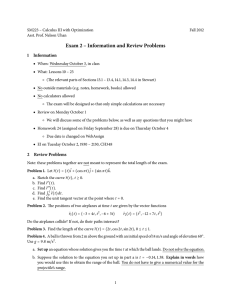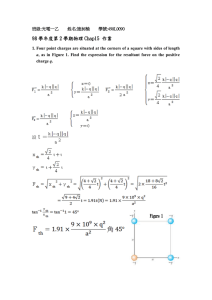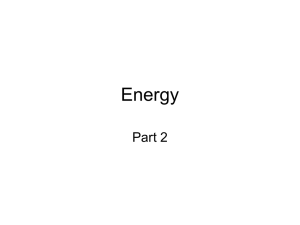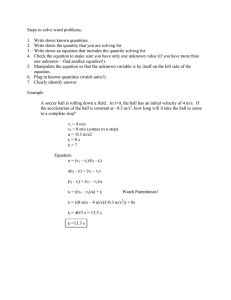The rolling ball problem on the sphere - IME-USP
advertisement
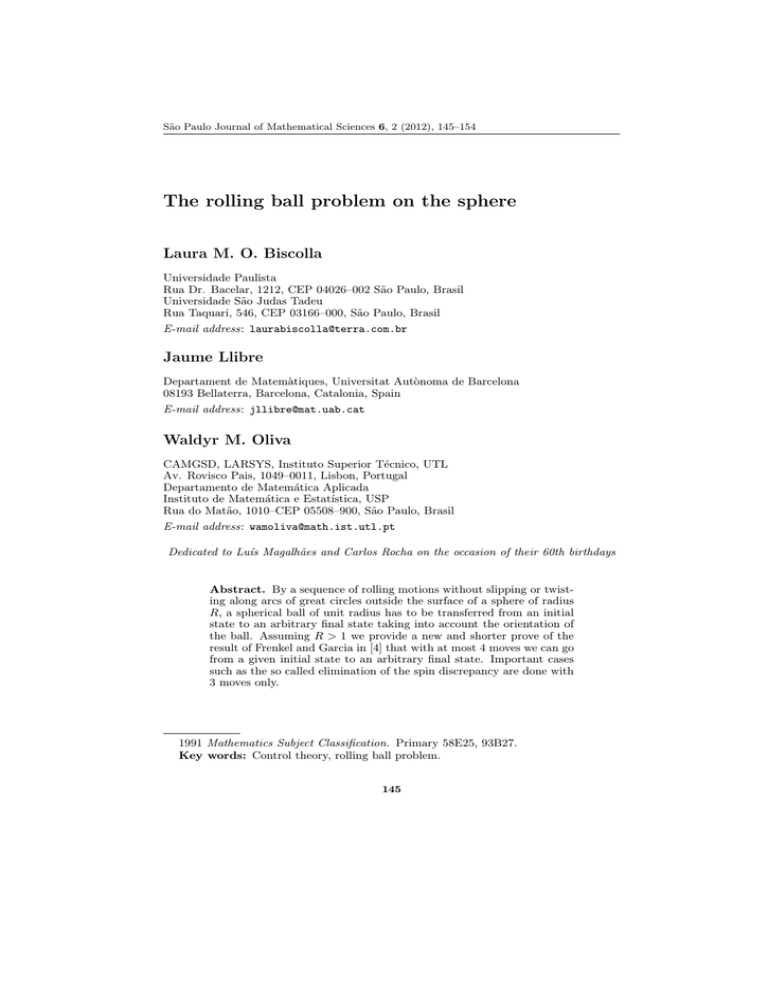
São Paulo Journal of Mathematical Sciences 6, 2 (2012), 145–154
The rolling ball problem on the sphere
Laura M. O. Biscolla
Universidade Paulista
Rua Dr. Bacelar, 1212, CEP 04026–002 São Paulo, Brasil
Universidade São Judas Tadeu
Rua Taquari, 546, CEP 03166–000, São Paulo, Brasil
E-mail address: laurabiscolla@terra.com.br
Jaume Llibre
Departament de Matemàtiques, Universitat Autònoma de Barcelona
08193 Bellaterra, Barcelona, Catalonia, Spain
E-mail address: jllibre@mat.uab.cat
Waldyr M. Oliva
CAMGSD, LARSYS, Instituto Superior Técnico, UTL
Av. Rovisco Pais, 1049–0011, Lisbon, Portugal
Departamento de Matemática Aplicada
Instituto de Matemática e Estatı́stica, USP
Rua do Matão, 1010–CEP 05508–900, São Paulo, Brasil
E-mail address: wamoliva@math.ist.utl.pt
Dedicated to Luı́s Magalhães and Carlos Rocha on the occasion of their 60th birthdays
Abstract. By a sequence of rolling motions without slipping or twisting along arcs of great circles outside the surface of a sphere of radius
R, a spherical ball of unit radius has to be transferred from an initial
state to an arbitrary final state taking into account the orientation of
the ball. Assuming R > 1 we provide a new and shorter prove of the
result of Frenkel and Garcia in [4] that with at most 4 moves we can go
from a given initial state to an arbitrary final state. Important cases
such as the so called elimination of the spin discrepancy are done with
3 moves only.
1991 Mathematics Subject Classification. Primary 58E25, 93B27.
Key words: Control theory, rolling ball problem.
145
146
L. M. O. Biscolla, J. Llibre and W. M. Oliva
1. Introduction and statement of the results
The rolling movements of a spherical ball B of unit radius over an oriented connected smooth surface S embedded in R3 suggest the consideration of some special kinematic (virtual) motions. A state of the ball is
defined to be the pair formed by the point of contact between B and S and
a positive orthonormal frame attached to B. Assume that the ball B rolls
freely on S, i.e. S ∩ B is the singleton of the contact point. So the set of
all the states is identified with the manifold M = S × SO(3), where SO(3)
denotes the group of orthogonal 3 × 3 matrices.
A move is a smooth path on M corresponding to a rolling of B on S
without slipping or twisting along a geodesic of the surface S. No slipping
in the rolling means that at each instant the point of contact between B
and S has zero velocity; no twisting means that, at each instant, the axis of
rotation must be parallel to the tangent plane of S at the point of contact.
According with John M. Hammersley the following problem was proposed by David Kendall in the 1950s: What is the number N of moves
necessary and sufficient to reach any final state of R2 × SO(3) starting at
a given initial state? In an interesting paper Hammersley [6] shows that
N = 3. Recently we have provided a new and short proof of this result, see
[3].
The following historical considerations we quote from [6] p.112: The
original version of the question set (by David Kendall in the 1950s) for
18-year-old schoolboys, invited candidates to investigate how two moves,
each of length π, would change the ball’s orientation; and to deduce in the
first place that N ≤ 11, and in the second place that N ≤ 7. Candidates
scored bonus marks for any improvement on 7 moves. When he first set
the question, Kendall knew that N ≤ 5; but, interest being aroused amongst
professional mathematicians at Oxford, he and others soon discovered that
the answer must be either N = 3 or N = 4. But in the 1950s nobody could
decide between these two possibilities. There was renewed interested in the
1970s, and not only amongst professional mathematicians: for example the
President of Trinity (a distinguished biochemist) spent some time rolling a
ball around his drawing room floor in search of empirical insight. In 1978,
while delivering the opening address to the first Australasian Mathematical
Convention, I posed the problem to mathematicians down under; but I have
not subsequently received a solution from them. So this is an opportunity
to publish the solution.
Hammersley [6] p.130 and Jurdjevic [7] are also interested in the same
problem but when the spherical ball of unit radius rolls without slipping or
twisting through arcs of great circles outside a sphere S2 of radius R > 1. In
São Paulo J.Math.Sci. 6, 2 (2012), 145–154
The rolling ball problem on the sphere
147
this case the manifold of states is identified with the set S2 × SO(3). In the
more general case M = S × SO(3) one asks: What is the minimum number
N (S) of moves sufficient to reach any final state of S × SO(3) starting at a
given initial state? For the case S = S2 (the sphere of radius R), it is known
that N (S2 ) is finite if R 6= 1, see Jurdjevic [7] pages 165–169 (section 5.1)
and Biscolla [2]. In fact, from the results of this last paper it can be proved
that the number N (S) is finite when the unit ball rolls without slipping
or twisting along geodesics of an analytic oriented connected and compact
surface of revolution which has everywhere Gaussian curvature different
from 1.
From now on we assume that all rolling motions are done outside the
surface of the sphere S2 .
Recently, Frenkel and Garcia [4] proved that if S2 is a sphere of radius
R > 1, then 3 ≤ N (S2 ) ≤ 4. In Theorem 8 of this paper, it is proved,
for any R > 1 and only three moves, the so called “elimination of the spin
discrepancy” (see [6]). We also provide a new and shorter proof of the
result of Frenkel and Garcia [4], that if R > 1, with at most 4 moves we
can go from a given initial state to an arbitrary final state (see Theorem
7).
We remark that the rolling ball problem on the sphere has special interest
in control theory and in robotics, see [7].
The paper is organized as follows. In section 2 we recall the Euler angles
and using these angles can get an easy representation of the elements of
SO(3). In section 3 we show that four moves are sufficient on S2 with
R > 1. In section 4 we see two important cases in which 3 moves are
sufficient on S2 including the elimination of the spin discrepancy .
2. Euler angles
According to Euler’s rotation theorem, any rotation of R3 , i.e. any element of the SO(3), may be described using three angles. If the rotations
are written in terms of rotation matrices R3 (a), R1 (b) and R3 (c), then a
general rotation M ∈ SO(3) can be written as
M = R3 (c)R1 (b)R3 (a),
where
R3 (a) =
cos a sin a 0
− sin a cos a 0
0
0
1
!
,
R1 (b) =
1
0
0
0 cos b sin b
0 − sin b cos b
!
,
São Paulo J.Math.Sci. 6, 2 (2012), 145–154
148
L. M. O. Biscolla, J. Llibre and W. M. Oliva
The three angles a, b and c are called Euler angles. There are several conventions for Euler angles, depending on the axes about which the rotations
are carried out. The so–called x–convention is the one we use, being also
the most common definition. In this convention a rotation is given by Euler
angles (a, b, c) where the first rotation is by an angle a about the z–axis,
the second is by an angle b in [0, π] about the x–axis and the third is by an
angle c about the z–axis.
The Euler angles are also related to the quaternions, which was the
approach used by Hammersley to study the rolling ball ball problem in the
plane (see [6]). For more details about the Euler angles see for instance [5].
A state (P, M ) ∈ S2 × SO(3) of the spherical ball on the surface of the
sphere S2 means that the contact point of the ball with the sphere is the
point P of S2 and its orientation is given by the rotation matrix M or its
associated orthonormal frame (I, J, K) of R3 , where the vectors I, J and
K are the first, second and third column of the matrix M , respectively.
Moreover the state (P, M ) is also denoted by (P, (I, J, K)).
We denote by (i, j, k) the orthonormal frame (I, J, K) associated to the
3 × 3 identity matrix Id.
3. Four moves are sufficient on S2
Let S2 = {(x, y, z) ∈ R3 : x2 + y 2 + z 2 = R2 }. The next proposition and
their corollaries essentially follow [4].
Proposition 1. Let {i, j, k} be the frame attached to the unitary ball of
center C = (0, 0, R + 1) with the vector k orthogonal to the sphere S2 of
radius R going from C to A = (0, 0, R + 2). Assume that the ball rolls along
the meridian M of S2 defined by the plane j–k. If after a rolling the vector
k goes to a vector u making an angle α with k, then the distance s (along
the meridian M) is equal to s = Rα/(R + 1), and the point A goes to a
point Ā, such that u is the vector from C̄ (the new position of the center of
the ball) to Ā.
Proof. It is easy to check that α = s + s/R.
s = Rα/(R + 1).
So we get that
Given two points P and Q on S2 the distance between P and Q, d(P, Q),
is the length of the small arc of the great circle containing P and Q. In
particular if P and Q are two points on S2 whose angle between them is
2π/(R + 1), the distance d(P, Q) is equal to 2πR/(R + 1).
São Paulo J.Math.Sci. 6, 2 (2012), 145–154
The rolling ball problem on the sphere
149
When rolling a ball from an initial state (P, M ) in S2 × SO(3) to a final
state (Q, M ) it is considered that P goes to Q along the arc of small length
of the great circle containing P and Q.
Hereafter when we say that a distance between two points is larger than
2πnR and smaller than 2π(n + 1)R we mean that we have done more than
n and less than n + 1 turns on the sphere along the great circle. With this
definition we have that d(P, P ) = 2πnR with n = 0, 1, 2, . . .
Corollary 2. If we start rolling the ball at the north pole of the sphere
S2 with the orientation M ∈ SO(3), then the curves on S2 on which the
orientation of the ball is M are parallels at a distance 2πnR/(R + 1) of the
north pole for n = 1, 2, . . . It can happen that some of these parallels can be
reduced to the north or south pole (if R + 1 divides 2n).
Proof. When the ball starting to roll at the north pole reaches in one move
a point of the parallel whose distance to the north pole is 2πnR/(R+1), the
ball has done exactly n complete turns. Therefore, the corollary follows. Corollary 3. Rolling the ball from the initial state (P, {i, j, k}) along a
great circle of length πR/(R + 1) + 2πnR/(R + 1), with n a positive integer,
then the orientation of the ball at the final state is given by an orthonormal
frame of the form {I, J, −k}.
Lemma 4. Let γ and σ be two great circles of S2 , and let P0 and Q0 be
two arbitrary points on γ and σ respectively. Consider Sγ (resp. Sσ ) to be
the set of points Pn of γ (resp. of σ) which are at distance 2πnR/(R + 1)
of the point P0 for n = 1, 2, . . . Then the distance between the points of Sγ
and Sσ is smaller than 2πR/(R + 1).
Proof. If γ coincides with σ the proof is trivial. Assume that γ is different
from σ. Let A be one of the two points of the intersection between γ and σ.
Clearly there are points of Sγ whose distance to A is at most πR/(R + 1)
and let Pr be one of such points. Similarly there is a point Qs of Sσ whose
distance to A is at most πR/(R + 1). Then the distance between Pr and
Qs is smaller than 2πR/(R + 1).
Lemma 5. Let R > 1, M ∈ SO(3) and P, Q ∈ S2 with P 6= Q. If the
distance between P and Q is smaller than 2πR/(R + 1) we can go from the
initial state (P, M ) to the final state (Q, M ) with 2 moves; otherwise we
need 3 moves.
Proof. Without loss of generality we can take P as the north pole of S2 .
By Corollary 2 and Lemma 4 it is clear that with one move we may assume
that on the sphere the distance d(P, Q) between P and Q is less than or
São Paulo J.Math.Sci. 6, 2 (2012), 145–154
150
L. M. O. Biscolla, J. Llibre and W. M. Oliva
equal to 2πR/(R + 1). We claim that given two different points P and Q
we have that
2πR
implies CP ∩ CQ 6= ∅,
d(P, Q) ≤
R+1
where CP =
∞
[
CPn with
n=1
CPn =
2πR
X ∈ S : d(X, P ) = n
R+1
2
.
Now we consider the following two cases.
Case 1: R is irrational. Then the set of parallels CP and CQ are dense in
S2 , and since P 6= Q they intersect. So the claim is proved in this case.
Case 2: R is rational. Then the set of parallels CP and CQ is finite. Let γ
be the great circle passing through P and Q. The intersection of γ with CP
is a finite set of equidistant points on γ which are located symmetrically
with respect to the diameter of γ passing through P . If some of the points
of γ ∩ CP different from P are located in the closed north hemisphere
of S2 , it is clear that CQ1 ∩ CP1 6= ∅. Otherwise we must have either
2πR/(R + 1) = πR, or 2πR/(R + 1) = 2πR/3. In the first case R = 1,
which contradicts the hypothesis that R > 1.
Assume 2πR/(R + 1) = 2πR/3, then R = 2 and CP is formed by the
point P and the parallel which is at a distance 2πR/3 of P . Again it follows
easily that CQ1 ∩ CP1 6= ∅. Hence the claim is proved.
So by Corollary 2 when d(P, Q) ≤ 2πR/(R + 1), it follows that 2 moves
are sufficient to go from (P, M ) to (Q, M ); it is enough to go from (P, M )
to (Z, M ) where Z is a point of CP ∩ CQ and from (Z, M ) to (Q, M ). It is well known that the rotation matrix R{e, δ} of angle δ around an
axis through the origin with direction e = (u, v, w) is
!
u2 + (v 2 + w2 ) cos δ
uv(1 − cos δ) − wL sin δ uw(1 − cos δ) + vL sin δ
1
uv(1 − cos δ) + wL sin δ
v 2 + (u2 + w2 ) cos δ
vw(1 − cos δ) − uL sin δ
,
L2
uw(1 − cos δ) − vL sin δ vw(1 − cos δ) + uL sin δ
w2 + (u2 + v 2 ) cos δ
√
where L = u2 + v 2 + w2 .
Now we shall describe the equation of any move starting at the north
pole (0, 0, R) of S2 . The great circles through the north pole are called
meridians. Let M be the meridian contained in the plane through the
origin with director vector e = (cos α, − sin α, 0). Then, by Proposition 1,
the move of length l starting at the north pole through the meridian M is
São Paulo J.Math.Sci. 6, 2 (2012), 145–154
The rolling ball problem on the sphere
151
given by the matrix
R{e, δ} with δ = l(R + 1)/R.
(1)
More precisely if we have at the north pole the ball with the orientation
given by the matrix M ∈ SO(3), after the move R{e, δ} the ball has the
orientation R{e, δ}M .
Lemma 6. The following two statements hold.
(a) Starting at the north pole with the orientation {i, j, k}, for every
n ∈ Z we can pass with one move to points P n of S2 with the
orientation given by the matrix
!
cos(a − c) − sin(a − c) 0
− sin(a − c) − cos(a − c) 0
,
(2)
0
0
−1
where a and c are arbitrary angles of S1 . The distance between the
points P n and P n+1 is 2πR/(R + 1).
(b) Starting at the north pole with an arbitrary orientation given by the
matrix R3 (c)R1 (b) R3 (a) with a, c ∈ S1 and b ∈ [0, π] (see section
2), for every n ∈ Z we can pass with one move to points Qn of S2
with the orientation given by the matrix (2). The distance between
the points Qn and Qn+1 is 2πR/(R + 1).
Proof. For every n ∈ Z take the move R{e, δ}Id given by (1) of length
l = πR/(R + 1) + n2πR/(R + 1) through the meridian M with director
vector e having α = (c − a)/2.
The point P n is the image of the north pole (0, 0, R) under the matrix
R{e, δ}. This completes the proof of statement (a).
For every n ∈ Z take the move R{e, δ}R3 (c)R1 (b)R3 (a) through the
meridian M with director vector e having α = c, where R{e, δ} is given by
(1) with length l = (b + π)R/(R + 1) + n2πR/(R + 1).
The point Qn is the image of the north pole (0, 0, R) under the matrix
R{e, δ}. This proves statement (b).
We now show that with 4 moves one can go from the state (P0 , (i, j, k))
to any other state (P1 , (I, J, K)).
Theorem 7. Let R > 1. Given two points P, Q ∈ S2 and M ∈ SO(3), we
can pass from the initial state (P, Id) to the final state (Q, M ) in 4 moves.
Proof. Let M = R3 (c)R1 (b)R3 (a) with a, c ∈ S1 and b ∈ [0, π].
Without loss of generality we can assume that the point P is the north
pole of the sphere. Then, for every n ∈ Z, using Lemma 6(a) and doing
São Paulo J.Math.Sci. 6, 2 (2012), 145–154
152
L. M. O. Biscolla, J. Llibre and W. M. Oliva
one move we can pass from the state (P, Id) to the states (P n , M0 ) where
M0 is the matrix (2), and where a, c are the angles appearing in the matrix
M.
Clearly the result proved in Lemma 6(b) can be applied to any point
of the sphere, not necessarily the north pole. Therefore, for every m ∈ Z
using Lemma 6(b) and doing one move we can pass from the state (Q, M )
to the states (Qm , M0 ) where M0 is the matrix (2).
Now by Lemma 4 there are two points P n and Qm whose distance is
smaller than 2πR/(R + 1). Finally, using Lemma 5, we can pass with two
moves from the state (P n , M0 ) to the state (Qm , M0 ), which concludes the
proof.
4. Cases in which three moves are sufficient on S2
The next result allows to go with 3 moves from the state (P0 , (i, j, k)) to
an arbitrary state of the form (P0 , (I, J, k)) which corresponds to (P0 , R3 (β))
for a certain β; this result is known as the elimination of the spin discrepancy β.
Theorem 8. Given the state (P0 , (i, j, k)) we can pass to the state
(P0 , (I, J, k)) doing 3 moves.
Proof. As usual we assume that P0 is the north pole of the sphere of radius R. We consider the spherical equilateral triangle whose vertices are
P0 = R(0, 0, 1) = Rp0 , P1 = R(0, sin(l/R), cos(l/R)) = Rp1 and P2 =
R(− sin α sin(l/R), cos α sin(l/R), cos(l/R)) = Rp2 and length l, where α is
the angle between the two great circles having vertex at P0 . Some basic
spherical geometry shows that cos α = cos(l/R)(1 − cos(l/R))/ sin2 (l/R).
Taking into account Proposition 1 the move from the state (P0 , Id) to the
state (P1 , M1 ) through the arc of the great circle of length l going from P0
to P1 is given by the matrix M1 = R(p0 ∧p1 /|p0 ∧p1 |, (1+R)l/R). Similarly
the move from the state (P1 , M1 ) to the state (P2 , M2 M1 ) through the arc
of the great circle of length l going from P1 to P2 is given by the matrix
M2 = R(p1 ∧ p2 /|p1 ∧ p2 |, (1 + R)l/R).
The move from the state (P0 , R3 (β)) to the state (P2 , M3 R3 (β)) through
the arc of the great circle of length l going from P0 to P2 is given by the
matrix M3 = R(p0 ∧ p2 /|p0 ∧ p2 |, (1 + R)l/R).
São Paulo J.Math.Sci. 6, 2 (2012), 145–154
The rolling ball problem on the sphere
153
It is now enough to prove that there exists l satisfying the equality
M2 M1 = M3 R3 (β). Take s = sin(l/R) satisfying
√
1 − s2 −s6 + 30s4 − 64s2 + 32 − 2 5s6 − 29s4 + 40s2 − 16
√
.
cos β =
s6
1 − s2 + 1
When s runs the interval [0.866025.., 1] the right hand side of the previous
expression covers the interval [−1, 1]. Hence for every β there exists some
l0 ∈ (0, π/2] satisfying the above equality. We checked using the symbolic
computational system Mathematica that for such a l0 we have M2 M1 =
M3 R3 (β).
The next result allows to go with 3 moves from the state (P0 , (i, j, k)) to
an arbitrary state of the form (P1 , (I, J, −k)).
Proposition 9. Let R > 1. Then, given the state (P0 , (i, j, k)), we can
pass to the state (P1 , (I, J, −k)) doing 3 moves.
Proof. For every n ∈ Z using Lemma 6(b) and doing one move we can
pass from the state (P0 , (i, j, k)) to the states (P n , (I, J, −k)). Since R > 1,
then by Lemma 5 we can pass from some state (P n , (I, J, −k)) to the state
(P1 , (I, J, −k)) with two moves. Hence the proposition is proved.
Acknowledgments
We thank to the referee all his comments and suggestions that allow us
to improve the presentation and exposition of this paper.
The second author has been supported by the grants MINECO/FEDER–
Spain MTM2008–03437, CIRIT–Catalonia 2009SGR 410, ICREA Academia
and FP7–PEOPLE–2012–IRSES–316338 and 318999. The third author
thanks to FCT (Portugal) for the partial support through Program
POCTI/FEDER and PDCT/MAT/56476/2004; and thanks also M.V.P.
Garcia for many valuable discussions on the subject.
References
[1]
[2]
[3]
[4]
V.I. Arnold and A. Avez, Ergodic problems of classical mechanics, Translated
from the French by A. Avez, W. A. Benjamin, Inc., New York–Amsterdam, 1968.
L.M.O. Biscolla, Controlabilidade do rolamento de una esfera sobre una superfı́cie de revoluçao, Ph. D., IME, USP, São Paulo, Brasil, 2005.
L.M.O. Biscolla, J. Llibre and W.M. Oliva, The rolling ball problem on
the plane revisited, to appear in Zeitschrift fuer Angewandte Mathematik und
Physik, 2013.
L.M. Frenkel and M.V.P. Garcia, Kendall’s problem on a sphere, Qualitative
Theory of Dynamical Systems 10 (2011), 333–341.
São Paulo J.Math.Sci. 6, 2 (2012), 145–154
154
[5]
[6]
[7]
L. M. O. Biscolla, J. Llibre and W. M. Oliva
H. Goldstein, The Euler Angles and Euler Angles in Alternate Conventions,
Section 4.4 and Appendix B in Classical Mechanics, 2nd ed. Reading, MA,
Addison–Wesley, pp. 143–148 and 606–610, 1980.
J.M. Hammersley, Oxford commemoration ball, Probability, statistics and analysis, Papers dedicated to David G. Kendall on the occasion of his sixty–fifth
birthday. Edited by J. F. C. Kingman and G. E. H. Reuter, London Math. Soc.
Lecture Note Ser. 79, Cambridge Univ. Press, Cambridge–New York, pp 112–142,
1983.
V. Jurdjevic, Geometric Control Theory, Cambridge Univ. Press, 1997.
São Paulo J.Math.Sci. 6, 2 (2012), 145–154
